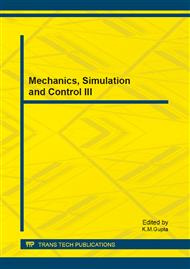[1]
Lesley A. Weitz and John E. Hurtado, Decentralized cooperative-control design for multivehicle formations, Journal of Guidance, Control and Dynamics, vol. 31, no. 4, 2008, pp.970-979.
DOI: 10.2514/1.33009
Google Scholar
[2]
H.B. Duan and S.Q. Liu, Non-linear dual-mode receding horizon control for multiple unmanned air vehicles formation flight based on chaotic particle swarm optimization, IET Control Theory and Applications, vol. 4, no. 11, 2010, pp.2565-2578.
DOI: 10.1049/iet-cta.2009.0256
Google Scholar
[3]
Brian D.O. Anderson, ChangbinYu, Soura Dasgupta and A. Stephen Morse, Control of a three-coleader formation in the plane, Systems & Control Letters, vol. 56, 2007, pp.573-578.
DOI: 10.1016/j.sysconle.2007.04.004
Google Scholar
[4]
Yunfei Zou and Prabhakar R. Pagilla, Distributed formation flight control using constraint forces, Journal of Guidance, Control and Dynamics, vol. 32, no. 1, 2009, pp.112-120.
DOI: 10.2514/1.36826
Google Scholar
[5]
Yu Gu, Brad Seanor, Giampiero Campa, Marcello R, Napolitano and Larry Rowe, et al, Design and flight testing evaluation of formation control laws, IEEE Transactions on Control Systems Technology, vol. 14, no. 6, 2006, pp.1105-1112.
DOI: 10.1109/tcst.2006.880203
Google Scholar
[6]
Xiaoyan Wang, Xinmin Wang, Yahui Xiao, Xiang Yu, Design of robust H∞ controller for UAVs three-dimensional formation flight, Control and Decision, vol. 27, no. 12, 2012, p.1907-(1911).
Google Scholar
[7]
Xiaoxiong Liu, Weiguo Zhang, Zhenhua Wang and Guangwen Li, Adaptive formation flight control design for UAVs, Journal of System Simulation, vol. 21, no. 5, 2009, pp.1420-1422.
Google Scholar
[8]
Min Song, Ruixuan Wei, Dong Shen and Minglang Hu, UAV formation control based on nonlinear dynamic inversion, Control and Decision, vol. 26, no. 3, 2011, pp.448-452.
Google Scholar
[9]
Dusan M S, Gokhan I, Rodney T and Claire J. T, Decentralized overlapping control of a formation of unmanned aerial vehicles, Automatica, vol. 40, no. 8, 2004, pp.1285-1296.
DOI: 10.1016/j.automatica.2004.02.017
Google Scholar


